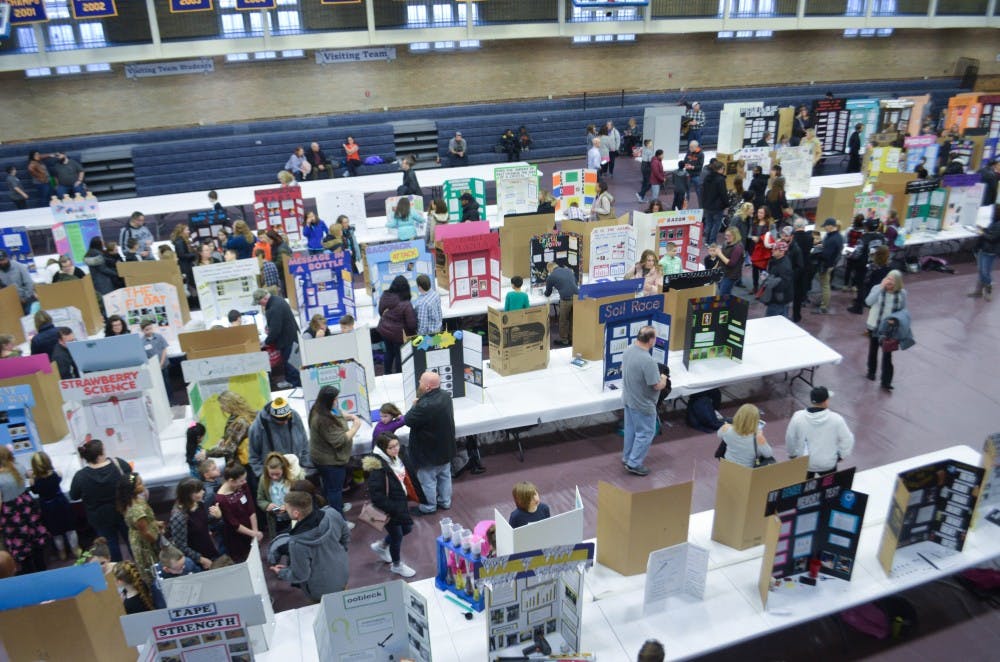Editor's Note: This story is part of The Partnership Project, a series of content written in an effort by The Daily News to follow the formal collaboration of Ball State University and Muncie Community Schools.
We’ve all been lied to — dogs’ mouths are not, in fact, cleaner than human mouths, according to an award-winning third-grade science experiment.
Eight-year-old Allison Bowley explained the facts to judges at the East Central Indiana Science Fair at Ball Gym Saturday morning.
For her experiment, the third grader at Yorktown Elementary swabbed the inside of three people’s mouths and three dogs' mouths, including her own dog, Rudy.
Then, she wiped the germs on six clean petri dishes and let them culture in a homemade incubator made from a plastic box and a bag.
“You want to smear it in a zigzag or any direction you choose,” Bowley said. “It doesn’t really matter.”
The finished petri dishes hung on Bowley’s white cardboard poster board, with the dogs’ dishes full of bacteria and the humans’ much emptier.
“The dogs actually don't brush their teeth,” she said, positing an explanation for how dirty her pet’s mouth was.
Bowley wants to be a scientist when she grows up, something organizers and judges of the science fair said they want to encourage in students as young as her.
Dr. Rona Robinson-Hill, a biology professor at Ball State and the organizer for the science fair, tries to do this in a number of ways, including her students serving Muncie with science education and by being involved in the Training Future Scientist Program.
In the program, students in the Muncie area can get a paid summer internship with faculty to help with research.
This is what 16-year-old Muncie Central junior Asia Wyatt did when she was paid to assist Ball State professor John McKillip with bacteria produced in dairy science.
Wyatt's findings, which she presented at the science fair, showed that there was a more efficient way for companies like Prairie Farms to the make probiotic bacteria which go into making yogurts and cheeses.
Unlike Bowley’s display, Wyatt’s was printed on a large white sheet of laminated poster, complete with photos of her working in a lab with test tubes.
What’s especially important about Wyatt’s opportunity, Robinson-Hill said, is that it opens doors for people in “underserved populations,” like Wyatt, who is African-American.
“It's not just African-American or Hispanic,” Robinson-Hill said. “There are a lot of children that live in poverty right now, too.”
Wyatt said she agrees with the equity she deserves from programs like hers.
“A lot of the times, on the surface, students are told that things like science aren't something that they can do,” Wyatt said. “So I think the Training Future Scientist program ... really gets us out into the world and open into the world. And I think just having more of an open mind about anybody who's underserved — students, adults, whatever — just encourages them that they can do whatever they put their mind to no matter how far or how hard it is.”
A judge for the science fair agreed. Melissa Evans said encouraging scientific growth is crucial, especially in the Muncie community.
“Moving into fields in science or going to higher education are all economic boosters," Evans said. “It's crucially important that we have groups of scientists that want to come to Ball State who can live in Muncie and can be around this environment and can learn to love Muncie, because that's ultimately what we need.”
Students who placed in each division will move on to the state science fair later this year.
Contact Sara Barker with comments at slbarker3@bsu.edu or on Twitter at @sarabarker326.





